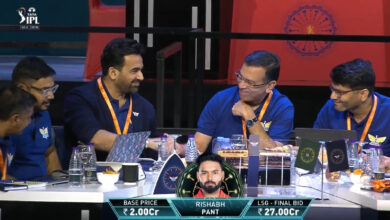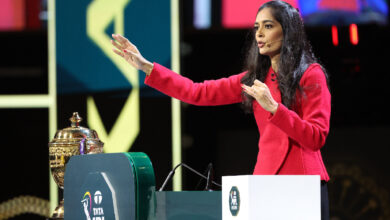Playing 140 overs in four hours, using baseball drills: The making of Yashasvi Jaiswal and Dhruv Jurel | Cricket News

Talegaon is as nondescript a village as they come. In the middle of nowhere, some 100 km from Nagpur. In a drict, Wardha, that hits the headlines mostly for a high farmer suicide rate. And the only industry, if it can be called one, is the manufacturing of iron products – daggers, knives and kitchenware.In this unlikeliest of places, from the house of Royals, the skills of two batsmen, sharp as knives, were honed. Yashasvi Jaiswal and Dhruv Jurel, India’s two big finds from the ongoing Test series against England, have spent weeks and months in Talegaon, training at the base of Rajasthan Royals, the Indian Premier League franchise they play for.
There are one too many uncanny similarities between Jaiswal and Jurel. The duo hails from Uttar Pradesh, Jaiswal from Bhadohi and Jurel from Agra. They left their homes early to chase their cricketing dreams. Played the U-19 World Cup together before being subsequently scouted the Rajasthan Royals. And even though their careers are at a nascent stage, they are already touted as India’s next-gen superstars.
Kumar Sangakkara, director of cricket of Rajasthan Royals, speaks to the team during a training session as Yashasvi Jaiswal (second from right) and Dhruv Jurel (centre).
With 655 runs, Jaiswal is the leading run-getter in the ongoing five-match Test series. Jurel, who has shown maturity beyond his age while batting at No 7, is already being compared to his idol MS Dhoni after his player-of-the-match effort in the Ranchi Test.
Behind their unprecedented emergence is a unique training programme designed some of the best cricketing brains who have been associated with the Rajasthan Royals, from Shane Warne and Rahul Dravid in the past to Kumar Sangakkara and Zubin Bharucha now.
In the l of stalwarts, Bharucha might not be a name that immediately stands out. But the 54-year-old, who has played all of 17 first-class matches, is known for unearthing diamonds from the rough.
In the cases of Jaiswal and Jurel, Bharucha says the ‘inherent hunger’ and ‘desperation to succeed’, coming from very humble backgrounds, gave him the necessary launchpad to mould them into top-class cricketers. He credits the Rajasthan Royals for providing him with the world-class infrastructure at Talegaon and the ‘vision of the franchise to put the country first’.
“The facility is world-class. We have 40 cricket wickets (Talegaon, Nagpur). (For) Each of those wickets, the soil has been brought up from different parts of India. We are trying to prepare our players to perform in different conditions,” Bharucha tells The Indian Express, adding that ‘you probably need 250 bowlers to produce one batsman’.
India’s Dhruv Jurel in action. (Photo: REUTERS)
‘140 overs in four-and-a-half hours’
Bharucha gives a glimpse into Jurel’s preparation before he was picked for India ‘A’, and eventually India.
“In a general practice session in cricket, you will see two fast bowlers, four spinners, that’s pretty much it. In one round a batter will play six balls max. For us, one round for the batsman is close to 15 deliveries,” he says.
From 14 yards, instead of 22, four players will throw the ball towards the batsman. Each of them serves a role and has been named cut, pull, flick and drive. Right behind these four ‘bowlers’ are another four who throw using a sidearm action. They are followed four spinners and finally, four fast bowlers.
“That constitutes one round,” Bharucha says. “When Dhruv Jurel came to Talegaon to practice before he went to play the Test match, he faced 140 overs in four-and-a-half hours. That’s the training model we have set, be it Dhruv, Jaiswal, Sanju (Samson), Riyan (Parag) or Devdutt (Paddikkal), who we traded this year to Lucknow Super Giants.”
The thinking, he adds, isn’t to make the player practice for any one format. The focus instead is on the quality of shots, position at the crease, and the pitch they are playing on.
“We are looking just at the quality of shots and where the ball is going. One of the practices we do is, we try to hit the ball where there are no fielders. But based on the fact is, what is your capability?”
Some of their takeaways were fascinating. In the IPL last year, Bharucha adds, ‘Jaiswal never played a shot through long on and mid-wicket’. “He was either hitting towards mid-off, cover and so on. We have been practising the slog shots over the over long-on and mid-wicket for the past two years. It was in this series, where he has perfected it,” he says.
Yashasvi Jaiswal’s evolution into 360-degree batsman
Jaiswal, in these Tests, has bolstered his reputation for playing 360-degree shots. That would have been a dant dream if the batsman would not have been open-minded in the training sessions and shown the willingness to spend hours practising the shots.
For the reverse sweep alone, Bharucha says they spent ‘close to six months’. He would sweep and reverse-sweep the same ball to the boundary until it was perfected. Sweep wasn’t the only shot he had to work on.
Yashasvi Jaiswal plays a shot on the fourth day of the third Test between England and India in Rajkot. (AP Photo)
After his first IPL, the biggest weakness in Jaiswal’s batting that Barucha pointed out was his inability to play shots on the on-side. And so, Bharucha employed baseball drills in developing Jaiswal’s power game.
“We used heavy bats. He played a lot with tennis balls and heavy balls but with different weights of bats as well. That’s something that comes from baseball. We have done that with Jurel, Yash, Riyan and Sanju as well. Yash’s power generation has gone through the roof,” Bharucha says.
The other technical aspects took a lot longer to improve. Eighteen months, to be precise. Jaiswal, Bharucha recalls, used to bend his elbow at the point of impact. Because of that, he couldn’t generate enough power.
“It is something that he was doing since his childhood. We knew that power was not there, so we started the alternatives such as reverse sweep. We have ensured that the elbow is not bent at the point of impact using different bats and balls.”
India’s Yashasvi Jaiswal celebrates his double century on the fourth day of the third Test match between England and India in Rajkot. (AP Photo)
Another flaw that Bharucha pointed out in Jaiswal’s batting was him hitting the ball straight to the fielders. That meant more hours on the training ground.
They put fielders in different positions and Jaiswal was challenged to pierce the gaps. If he’d play the cut shot, he had to try and beat two fielders at point, a short third man, and one in front of point. “And when I say that he is constantly trying to beat those fielders in practice, it is not for just five balls. It is 200-300 balls where he is trying to pierce the gap. In the match, you can see every time he will hit, he will pick the gap,” he says.
Dhruv Jurel working with Rajasthan Royals’ strength and conditioning coach A T Rajamani Prabhu
Influence of the Royals dressing room
There is something unique about the Rajasthan Royals dressing room since the inaugural season of the IPL, where they lifted the trophy under Shane Warne. That legacy has been passed on to Rahul Dravid and now Sangakkara and Bharucha.
England white-ball captain Jos Buttler has recently posted a heartfelt post on why he is enjoying Jaiswal’s batting even though it is coming against England. Buttler, who opens with Jaiswal in the IPL, was among the first to wish the southpaw after he made his Test debut.
The same is true with Root and Jurel. Root shared his contact number with Jurel after the end of the IPL last year and told him to stay in touch. The England batter was one of the first, who raced towards Jurel after he got out on 90 in Ranchi.
“His ability to strike cleanly and blast the ball to all parts from ball one is impressive. But to be able to transfer skills to Test format [means] he has got very sound technique,” Root had opined on his former Royals teammates.
These exchanges capture the true essence of the IPL, where young players get to mingle with established Indian pros and foreign players.
That alone, however, isn’t the reason why Jaiswal and Jurel have made it this far, Bharucha says. “Mentoring and passing on knowledge and information is one aspect but putting in the hard yard, slog and effort, the blood and the sweat is upon the athletes.
“The preparation these guys are putting in and the hour they are devoting to the skill is quite extraordinary. To bat 140 overs in four hours, I can almost tell you that (there are) less than five and seven people in the whole world who can possibly do that. The credit must go to Yash and Jurel for doing it. You cannot substitute it in any other way or form. This is not a one-time thing, Jurel has been doing it for 18 months. The same is true with Yash.”







